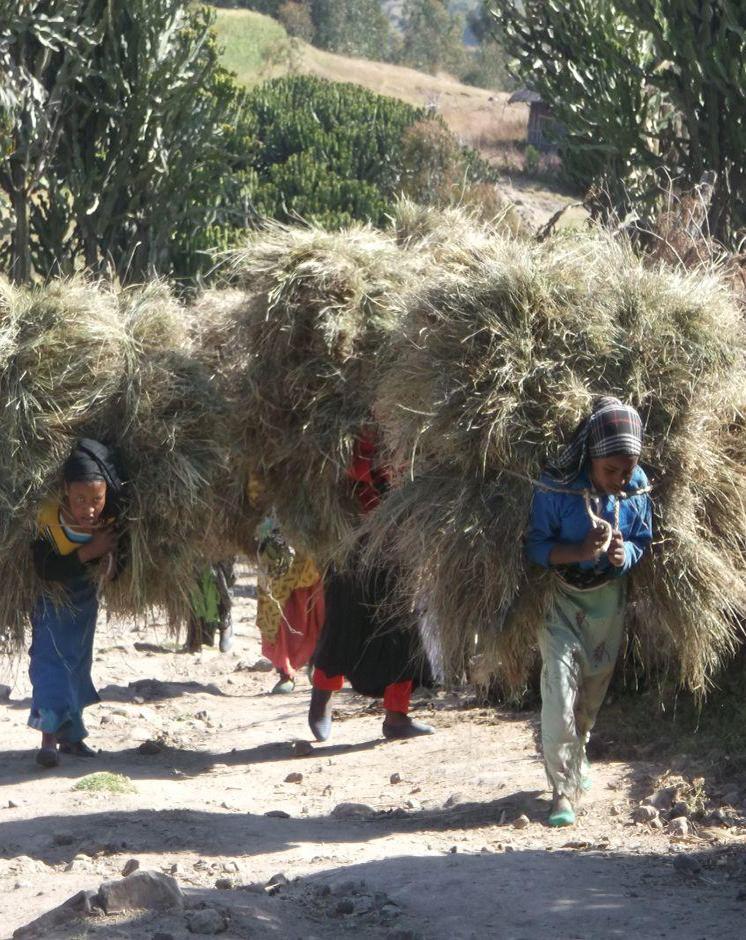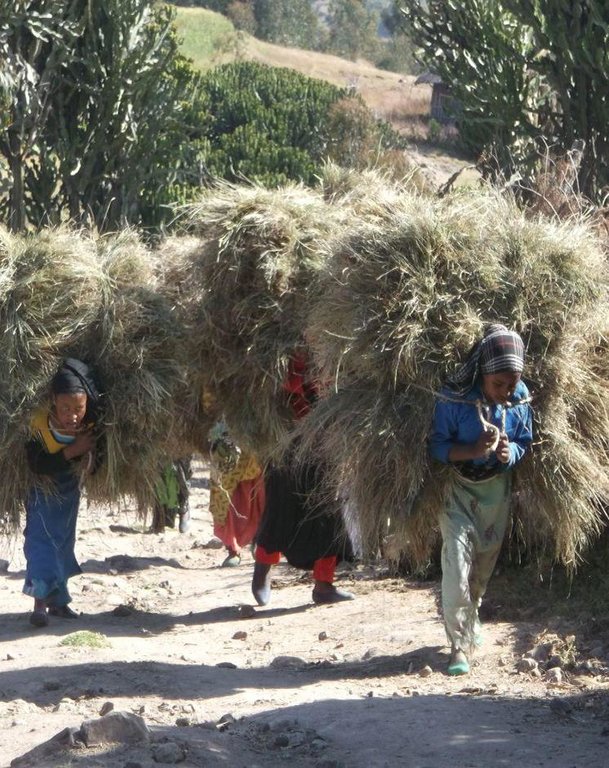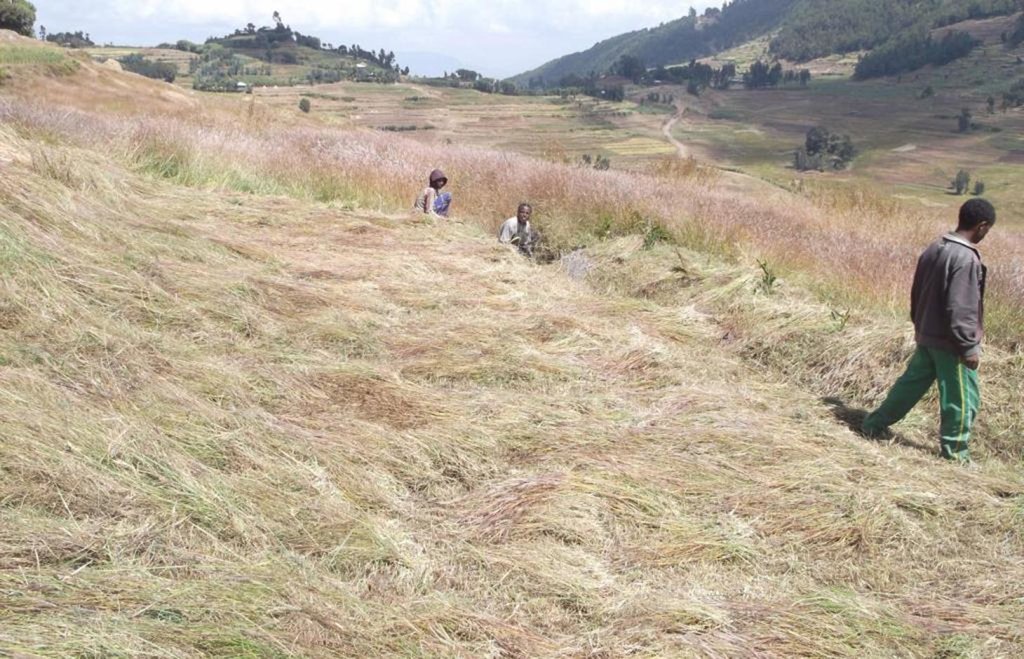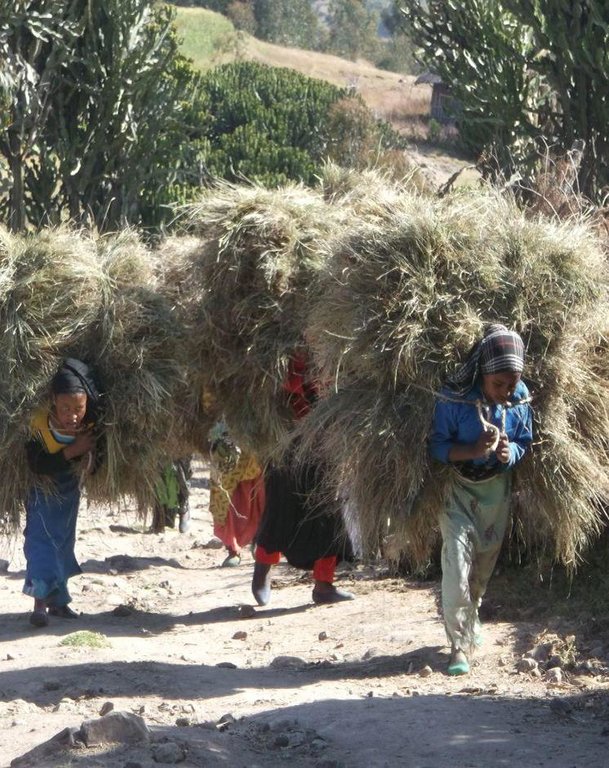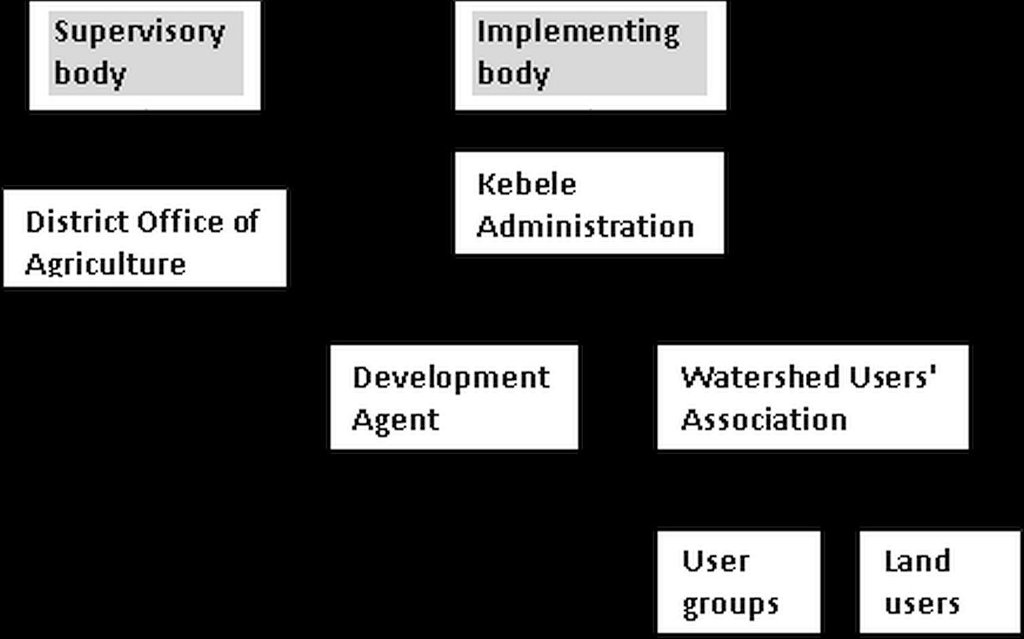'Cut and Carry' Grazing system or 'Zero Grazing' (CCG) [埃塞俄比亚]
- 创建:
- 更新:
- 编制者: Gizaw Desta Gessesse
- 编辑者: –
- 审查者: Fabian Ottiger
Ensesa Asro Memgeb (Amharic)
approaches_2497 - 埃塞俄比亚
查看章节
全部展开 全部收起1. 一般信息
1.2 参与方法评估和文件编制的资源人员和机构的联系方式
SLM专业人员:
Melese Bekure
WLRC
埃塞俄比亚
有助于对方法进行记录/评估的机构名称(如相关)
Water and Land Resource Centre (WLRC) - 埃塞俄比亚1.3 关于使用通过WOCAT记录的数据的条件
(现场)数据是什么时候汇编的?:
16/05/2014
编制者和关键资源人员接受有关使用通过WOCAT记录数据的条件。:
是
1.4 SLM技术问卷的参考
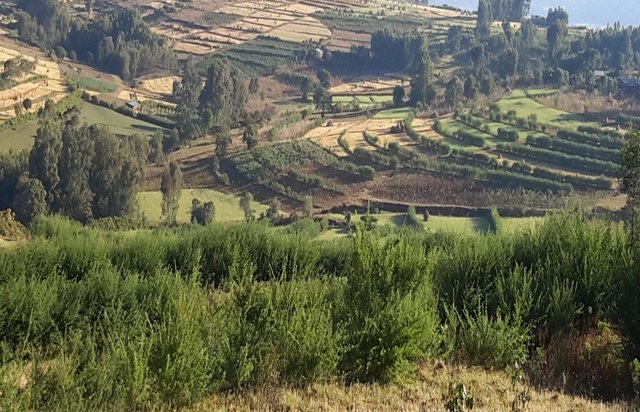
Vegetated graded soil bund [埃塞俄比亚]
Vegetated graded soil bund is a soil conservation practice meant for cultivated lands and constructed by excavating graded channel on upper side and develop embankment on lower side which is planted with grass or shrub species in order to control soil erosion and drain excess runoff implemented through community mobilization.
- 编制者: Gizaw Desta Gessesse
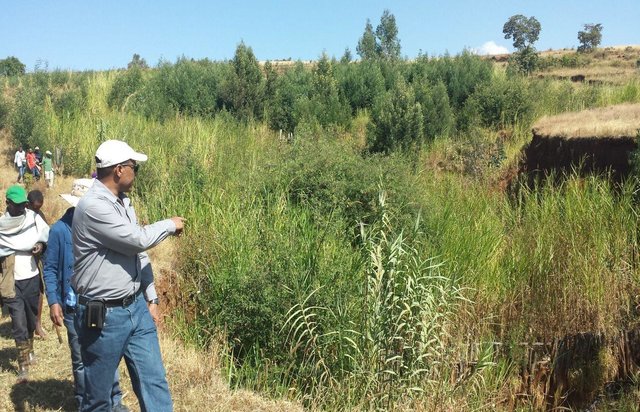
Gully erosion management [埃塞俄比亚]
Gully erosion management is the application of combination of practices to control excess or concentrated runoff generation in the gully upstream catchment area, divert excess runoff upstream of gully heads and control further development of gully using appropriate structural and vegetative measures in the head, bed and sides of the …
- 编制者: Gizaw Desta Gessesse
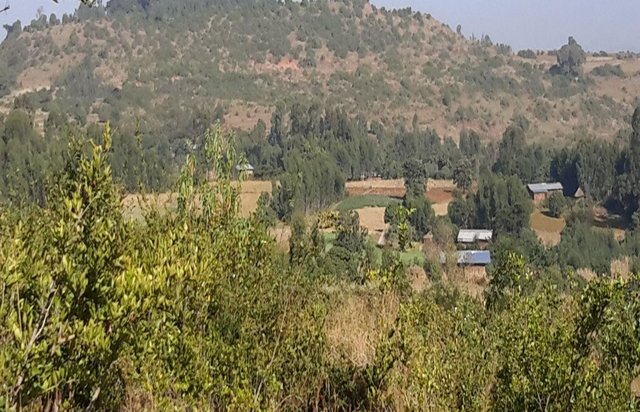
Area closure on degraded lands [埃塞俄比亚]
Area closure on degraded lands is a land management practice used to rehabilitate and conserve the natural resource bases, and enhance its natural regeneration and restoring capacity and productive functions by excluding animal and human interferences through community consultation and collective actions.
- 编制者: Gizaw Desta Gessesse
2. SLM方法的描述
2.1 该方法的简要说明
Cut and carry grazing system (alternatively called zero grazing) is an approach where the community is consulted to identify and agree on areas to be closed and protected from free grazing; establish user groups are established to share the fodder biomass harvested from communal closed areas equitably; they utilize tree/shrub fodder planted on bunds.
2.2 该方法的详细说明
该方法的详细说明:
Aims / objectives: Zero grazing aims to reduce the impact of livestock management on land degradation. The objectives are: 1) implement cut and carry grazing system by establishing user groups for equitable share of biomass, 2) increase forage quantity and quality by improving the fodder and grass biomass production per unit area, 3) Protect further soil degradation and vegetation loss
Methods: Cut and carry employs series discussion with community to identify zero grazing sites and set bylaws to implement the approach. The watershed committee together with Development Agents and Kebele administration consult the community to identify and decide on the right beneficiaries of benefits gained from closed communal areas. Once the community agrees on the bylaws, the Kebele unit council approved and passed to district court for endorsement. The watershed committee, now renamed as Watershed Users Association, is the legitimate body authorized to regulate watershed management and benefit sharing among entitled users. The money collected from penalty fee from those who violate the rules use as a revolving fund to be used for other watershed development activities. The beneficiaries organize themselves into groups and they divided the benefits on equaitable basis at every harvest season. The users keep their animals around homes or sheds and feed them on harvested fodder/grass.
Stages of implementation: 1. Consultation and discussion with community in order to identify areas free from livestock access, formulate bylaws, control free grazing, and protect the developed watersheds from livestock interference,
2. Identification and organization of right beneficiaries into user groups who actually used to benefit previously on the selected area and new users that are believed to share the benefit,
3. Undertaking treatment of area closures with biological, structural and land use management measures as well as planting bunds on crop lands with fodder and grass species,
4. Watershed Committee start to implement or enforce the agreed bylaws on those who violate the rules (allow livestock in the protected areas, harvest biomass or cut tree from closed areas by untitled users, etc.),
5. Utilization of the biomass by user group members through equal share of the harvested biomass.
Role of stakeholders: Community: The community was responsible to select closed areas from livestock interference, identify beneficiaries, harvest and utilize the biomass as per the agreement, and respect and comply with the rules/bylaws;
Development agents: Supported the watershed committee in regulating protected areas, provide technical advice in the implementing integrated watershed interventions and subsequent maintenance activities or operations, and provide awareness creation and training about fodder utilization;
Watershed committee/watershed users association: It played the key role in planning, managing the developed watershed and regulate the benefit utilization arrangements. It applies the rules for those who do not comply with;
Kebele administration: The administration was responsible to control and manage the overall activities and supervise the implementation
Command post: Both the district and kebele command post (adhoc committee) is responsible to supervise the activities and solve problems;
Research: research involved to take part in introducing improved technologies that increase biomass production (like improved species with high quality and biomass) and efficiency (harvesting and packaging implements);
Project/WLRC: Provided material and technical support for the planning, implementation and monitoring activities.
Other important information: Cut and carry grazing system is an important intervention in the Ethiopian farming system where livestock and crop farming are mixed and livestock husbandry is means of crop production and household asset. Livestock farming is a subsistence production, which is not yet commercialized.
2.3 该方法的照片
2.5 采用该方法的国家/地区/地点
国家:
埃塞俄比亚
区域/州/省:
Amhara National Regional State
有关地点的进一步说明:
Bahir Dar Zuria, Mecha, Yilmna Densa, Dessie Zuria
2.6 该方法的开始和终止日期
注明开始年份:
2011
2.7 方法的类型
- 基于项目/方案
2.8 该方法的主要目的/目标
The Approach focused on SLM only
The main objectives of cut and carry or zero grazing is protection of land degradation and loss of vegetation on communal lands and controlling damage on the soil and water conservation measures implemented on watersheds. Specifically, it is to practice cut and carry feeding system by establishing equitable share of biomass among user groups, increase quantity and quality of forage, and protect further degradation of land and loss of vegetation.
The SLM Approach addressed the following problems: The main problems targeted to address by implementing cut and carry or zero grazing approach are: growing challenges of land degradation due to overgrazing and compaction/trampling effects; growing shortage of livestock feed; lack of communal land resource management regulation and actions.
2.9 推动或妨碍实施本办法所适用的技术的条件
财务资源和服务的可用性/可得性
- 阻碍
Inadequate diversification of income from livestock production due to its low carrying capacity of the grazing lands, low input and technology supply as well as low financial capacity of farmers
Treatment through the SLM Approach: Zero grazing approach helps to increase livestock productivity and attain better weight gain for market.
机构设置
- 阻碍
Lack of common property management and regulation to share benefits equitably among users. There is reluctance to respect local initiated bylaws to stop free grazing.
Treatment through the SLM Approach: Watershed committee is institutionalized to govern zero grazing implementation procedures and entitle use rights to right beneficiaries in a group.
法律框架(土地使用权、土地和水使用权)
- 阻碍
The existing land ownership, land use rights / water rights moderately hindered the approach implementation Since there is tradition of open access grazing (animals allowed to graze freely) and pasture lands are communally used, this tradition affects the sustainability of the approach. Although there are community bylaws attempted to enforce through the watershed committee, farmers not yet fully practice cut and carry system of grazing. This, because they wanted to maximize the benefit by entitling individual use rights for communal land resources.
了解SLM,获得技术支持
- 阻碍
Lack of immediate feed options and lack of knowledge of improved fodder production and forage utilization.
Low level of understanding about multiple advantages of zero grazing. Degradation of natural resources in the form of compaction, loss of organic matter and soil erosion and damage to grass and plant biodiversity.
Treatment through the SLM Approach: The approach support to build the skill and knowledge of users about the forage production and utilization techniques by research actors as well it enables to understand feed requirement per household.
3. 相关利益相关者的参与和角色
3.1 该方法涉及的利益相关者及其职责
- 当地土地使用者/当地社区
The watershed Users Association, kebele administration and development agents
Individual land users has to play role to control free grazing and practice zero grazing. The closed areas are owned in group and need to protect and control in group. The role of men was mainly dedicated to control free grazing activities and involved in harvesting forage. Women were involved in the plantation of vegetative measures, in bunds and area closures, they took care of animals around their homestead, sometimes they transported forage/biomass for livestock. The approach entitled those who do not own animals to share the biomass collected from communal closed areas. They earned cash by selling the biomass harvest for forage purpose.
- SLM专家/农业顾问
They are involved in the planning, support and supervision of the implementation, monitoring and evaluating the implementation
- 地方政府
The district agriculture office
- 国家政府(规划者、决策者)
Decision makers
They play role to enforce the rules and mobilize the community to control free grazing
3.2 当地土地使用者/当地社区参与该方法的不同阶段
| 当地土地使用者/当地社区的参与 | 指定参与人员并描述活动 | |
|---|---|---|
| 启动/动机 | 无 | |
| 计划 | 互动 | The community and individual land users agree to delineate areas closed from free grazing. At this stage land users should involve and agree. |
| 实施 | 互动 | land users need to participate and involve actively to control free grazing and practice cut and carry feeding system. |
| 监测/评估 | 互动 | Land users are involved in the evaluation and field days. |
| Research | 互动 | Land users are involved in participatory technology generation and promotion. |
3.3 流程图(如可用)
具体说明:
The district office of agriculture together with its Kebele unit is the supervisory body for implementing cut and carry or zero grazing approach. The main implementers are the kebele administration, the watershed users' association and development agents. The Watershed Users' Association (WUA) or sometimes called watershed committee is the implementer of the daily activities or operations to manage and regulate developed watersheds and specifically zero grazing approach by enforcing the agreed bylaws. The Kebele administration unit support and manage administrative matters associated to zero grazing while the development agents assist the WUA and user groups on technical issues. User groups and land users are part of the implementation of the processes.
作者:
Gesesse, Gizaw Desta (WLRC, P.O.Box 8707, Addis Abeba, Ethiopia)
3.4 有关SLM技术选择的决策
具体说明谁有权决定选择要实施的技术:
- 主要是SLM专家,咨询土地使用者之后
解释:
Decisions on the method of implementing the SLM Technology were made by mainly by SLM specialists with consultation of land users
4. 技术支持、能力建设和知识管理
4.1 能力建设/培训
是否为土地使用者/其他利益相关者提供培训?:
是
明确受训人员:
- 土地使用者
- 现场工作人员/顾问
- leaders at local level
如果相关,请说明性别、年龄、地位、种族等。:
Awareness creation is provided to all land users both men and women, development staff and local leaders.
培训形式:
- 农民对农民
- 示范区域
- 公开会议
涵盖的主题:
Magnitude and extent of land degradation and the impact of livestock pressure on depletion of natural resources. The community was advised to reduce livestock number and to rely on small number of improved breeds supplemented with intensive forage production and treated crop residues. Development staff was involved in trainings about forage production and management. Leaders also took part in trainings and awareness workshops about land degradation and natural resources conservation.
4.2 咨询服务
土地使用者有权使用咨询服务吗?:
是
指明是否提供了咨询服务:
- 在固定中心
说明/注释:
Name of method used for advisory service: Participatory Demonstration and Training Extension System (PADETES); Key elements: Training and awareness creation of farmers in Farmer Training Centers (FTC), Provision of inputs and package, and demonstrations on the Farmer Training Centers (FTC) and experience sharing visits, On job training; The method gives high emphasis to training and to some extent practical demonstrations supported with experience
sharing visits but less emphasis to advisory of farmers on site.
Advisory service is quite adequate to ensure the continuation of land conservation activities; The extension system is quite adequate to ensure continuation of activities. The government service is adequate to ensure the implementation. Furthermore, if the newly structured and formulated Watershed Users Association functions well, it is sufficient to regulate the approach and sustain land conservation.
4.3 机构强化(组织发展)
是否通过这种方法建立或加强了机构?:
- 是,适度
具体说明机构的强化或建立程度:
- 本地
具体说明支持类型:
- 能力建设/培训
提供进一步细节:
The support is mainly awareness creation and training. The local institutions like watershed users association, User Groups, Farmer Training Centers are supported by training.
4.4 监测和评估
监测和评估是该方法的一部分吗?:
是
注释:
bio-physical aspects were ad hoc monitored by project staff, government, land users through observations; indicators: Free grazing by animals; land users who practice zero grazing
bio-physical aspects were regular monitored by project staff through measurements; indicators: Forage biomass harvested and shared among the land users
technical aspects were ad hoc monitored by project staff, government, land users through observations; indicators: Fattening practice; change in animal body performance
socio-cultural aspects were ad hoc monitored by project staff through observations; indicators: Formation of User Groups and share of benefits; Conflict reduction; role of actors
economic / production aspects were ad hoc monitored by project staff, government through observations; indicators: Fattening benefits;
area treated aspects were ad hoc monitored by project staff through observations; indicators: Area covered by zero grazing
no. of land users involved aspects were ad hoc monitored by project staff, land users through observations; indicators: Land users who practice zero grazing or who voilate the rules
management of Approach aspects were regular monitored by None through measurements; indicators: Damage to treated areas by free grazing
There were several changes in the Approach as a result of monitoring and evaluation: As a result of monitoring and evaluation the practice of zero grazing is expanded. Strict enforcement of the bylaws brought change in zero grazing practices and some also attempted to reduce their livestock number
There were no changes in the Technology as a result of monitoring and evaluation
4.5 研究
研究是该方法的一部分吗?
是
明确话题:
- 生态学
- 技术
提供进一步的细节,并指出是谁做的研究:
The research support is most of the time in form of on-farm research. Research is part of the approach. The research provides technical backstopping by introducing improved agricultural technologies like improved forage species and breeds that complement the SLM technologies where the approach is designed for.
Research was carried out on-farm
5. 融资和外部物质支持
5.1 该方法中SLM组成部分的年度预算
如果不知道准确的年度预算,请给出一个范围:
- 10,000-100,000
注释(例如主要的资助来源/主要捐助者):
Approach costs were met by the following donors: local government (district, county, municipality, village etc) (Through technical and material support and capacity building): 28.0%; local community / land user(s) (For scouting by Watershed Users Association, free labor for implementation, and sometimes wage for guards): 72.0%
5.2 为土地使用者提供财政/物质支援
土地使用者是否获得实施该技术的财政/物质支持?:
是
如果是,请具体说明支持的类型、条件和提供者:
The inputs like seedlings and grass splits raised in the nurseries for the implementation of vegetative measures and other technologies that support the efficiency and management of the SLM technologies are supported by the government and/or projects.
5.3 对特定投入的补贴(包括劳动力)
- 设备
| 具体说明哪些投入得到了补贴 | 程度如何 | 对补贴做出具体说明 |
|---|---|---|
| 工具 | 部分融资 | Hand tools for construction |
- 农业
| 具体说明哪些投入得到了补贴 | 程度如何 | 对补贴做出具体说明 |
|---|---|---|
| 种子 | 充分融资 | Tree seedlings and grasses |
如果土地使用者的劳动力是一项重要的投入,那么是不是:
- 自愿
注释:
The labor is totally contributed by land users voluntarily through community mobilization approach.
5.4 信用
是否根据SLM活动的方法给予信用值?:
否
6. 影响分析和结论性陈述
6.1 方法的影响
该方法是否帮助土地使用者实施和维护SLM技术?:
- 否
- 是,很少
- 是,中等
- 是,支持力度很大
The approach aim to rehabilitate unproductive and degraded lands and thereby the soil moisture and biomass productivity improve. It also helps to increase the level of awareness to protect and manage communal resources and share of benefits out of it. It also gradually increases the ecosystem services such as increase the duration of flow of streams, increase stream flow and water availability, improve the diversity of plant species, and improve the micro-climatic conditions.
该方法是否有助于社会和经济弱势群体?:
- 否
- 是,很少
- 是,中等
- 是,支持力度很大
Land users who do not have animals also share the benefit equally with the land users who own animals. Thus, they improve their situation by selling grass biomass for feed. Others also employed to prepare and raise tree and grass seedlings in nurseries.
该方法是否改善了阻碍SLM技术实施的土地使用权/用户权问题?:
- 否
- 是,很少
- 是,中等
- 是,支持力度很大
Forage biomass production and improved forage development were parts of the SLM technologies help to reduce the feed shortage problem. The approach is thus help to improve feed shortage by producing alternative fodder production strategies on bunds, gullies, area closures and backyards while controlling free grazing by implementing community agreed bylaws and setting entitlement to group use rights.
Did other land users / projects adopt the Approach?
- 否
- 是,很少
- 是,中等
- 是,支持力度很大
The cut and carry system is gradually expanded to adjacent watersheds and villages after sharing experiences during field days. Land users become aware of the benefits of cut and carry system on livestock production and health. Experts and leaders from other districts visited the approach and plan to expand to their areas.
Did the Approach lead to improved livelihoods / human well-being?
- 否
- 是,很少
- 是,中等
- 是,支持力度很大
In two years project life, some land users particularly youths involve in apiculture production using the areas closed for zero grazing, and some others practiced fattening using the biomass harvest from area closures and vegetated fodder trees on bunds.
Did the Approach help to alleviate poverty?
- 否
- 是,很少
- 是,中等
- 是,支持力度很大
Cut and carry or zero grazing approach allowed some land users to use improved animal breeds and fattening practices that increase productivity and reduce poverty.
6.2 土地使用者实施SLM的主要动机
- 增加生产
The Immediate interest is to gain biomass harvest from area closures for livestock production
- 支付/补贴
Some land users are motivated to gain in kind material support in kind like seeds, seedlings, breed
- 规章制度(罚款)/执行
Gain benefit through equitable share of benefits from area closures
- well-being and livelihoods improvement
Introduction of fattening and synchronization using improved fodder production for livestock
6.3 方法活动的可持续性
土地使用者能否维持通过该方法实施的措施(无外部支持的情况下)?:
- 是
若是,请说明如何维持:
It can be sustained if adequate technology supply, effective capacity development, and regulatory systems become effective. Additional efforts on increasing the technical skill of farmers and especially for members of Watershed Users Association on regulatory practices by employing continuous awareness creation, training and demonstration activities.
6.4 该方法的长处/优点
| 土地使用者眼中的长处/优势/机会 |
|---|
| The approach give benefit to those who have less power within the community. (How to sustain/ enhance this strength: Strengthen and empower user groups in particular and watershed users' association in general.) |
| Improved body performance of the animals treated in zero grazing. (How to sustain/ enhance this strength: Provide continuous advisory services to land users in order to implement zero grazing and practice fattening.) |
| 编制者或其他关键资源人员认为的长处/优势/机会 |
|---|
| Increase the attitude and knowledge of land users about land degradation and sustainable land management. (How to sustain/ enhance this strength: Launch continuous training sessions or capacity building activities in the Farmer Training Centers (FTC).) |
|
Degraded lands become rehabilitated and productive and off-site ecosystem services enhanced, and restore the lost plant biodiversity on degraded lands and waste lands. (How to sustain/ enhance this strength: Maintain interventions and comply with agreed bylaws. ) |
|
Strengthen grass root level institutions that govern the management of resources in watersheds. (How to sustain/ enhance this strength: Provide support and increase their technical and financial capacity.) |
|
Communal degraded lands are entitled to organized use rights and gives opportunity to those who do not access benefit from communal lands. (How to sustain/ enhance this strength: Strengthen the Watershed Users Association and user groups.) |
|
Enable to introduce improved livestock production system that improve livestock productivity as a result of controlled feeding and avoidance of long distance movement of animals and gradually change from subsistence to (semi) commercial production. (How to sustain/ enhance this strength: Provide technical support and link to market information and opportunities.) |
6.5 该方法的弱点/缺点以及克服它们的方法
| 土地使用者认为的弱点/缺点/风险 | 如何克服它们? |
|---|---|
| Zero grazing applies only when the number of animals per household is minimum while large livestock flock size is required to use for trampling and as a risk aversion mechanisms. | Options of agronomic practices without trampling and other agricultural implements that substitute trampling has to be introduced and adopted. |
| The approach has limitations in areas where there is forage constraints and shortage of communal land for grazing purposes. | Introduce intensive forage production systems (for example backyard) that improve productivity per unit area. |
| 编制者或其他关键资源人员认为的弱点/缺点/风险 | 如何克服它们? |
|---|---|
| All land users were not equally committed and took accountability. | Motivate and engage them in every decision making process. |
| Inadequate support to watershed committee in enforcing the rules from higher level administrative units. | Establish forums or platforms for discussing challenges and solve problems. |
7. 参考和链接
7.1 方法/信息来源
- 实地考察、实地调查
- 与土地使用者的访谈
7.2 参考可用出版物
标题、作者、年份、ISBN:
Area closure. WLRC Brief No. 2 June 2015
可以从哪里获得?成本如何?
www.wlrc-eth.org
链接和模块
全部展开 全部收起链接

Vegetated graded soil bund [埃塞俄比亚]
Vegetated graded soil bund is a soil conservation practice meant for cultivated lands and constructed by excavating graded channel on upper side and develop embankment on lower side which is planted with grass or shrub species in order to control soil erosion and drain excess runoff implemented through community mobilization.
- 编制者: Gizaw Desta Gessesse

Gully erosion management [埃塞俄比亚]
Gully erosion management is the application of combination of practices to control excess or concentrated runoff generation in the gully upstream catchment area, divert excess runoff upstream of gully heads and control further development of gully using appropriate structural and vegetative measures in the head, bed and sides of the …
- 编制者: Gizaw Desta Gessesse

Area closure on degraded lands [埃塞俄比亚]
Area closure on degraded lands is a land management practice used to rehabilitate and conserve the natural resource bases, and enhance its natural regeneration and restoring capacity and productive functions by excluding animal and human interferences through community consultation and collective actions.
- 编制者: Gizaw Desta Gessesse
模块
无模块


